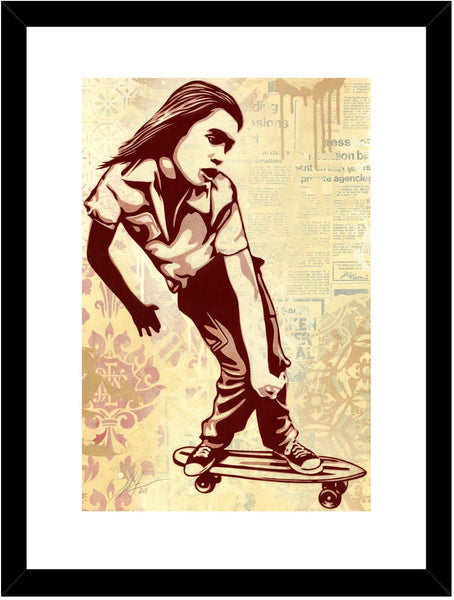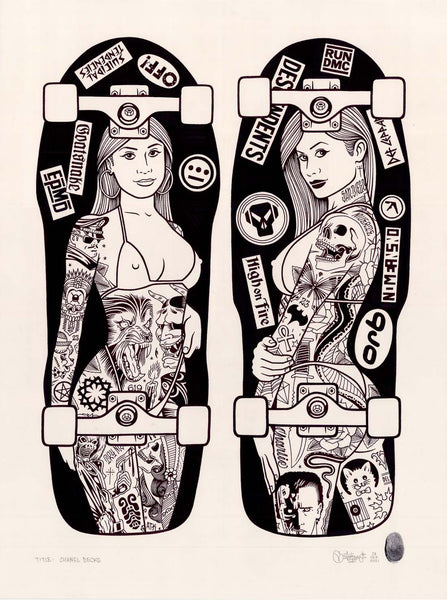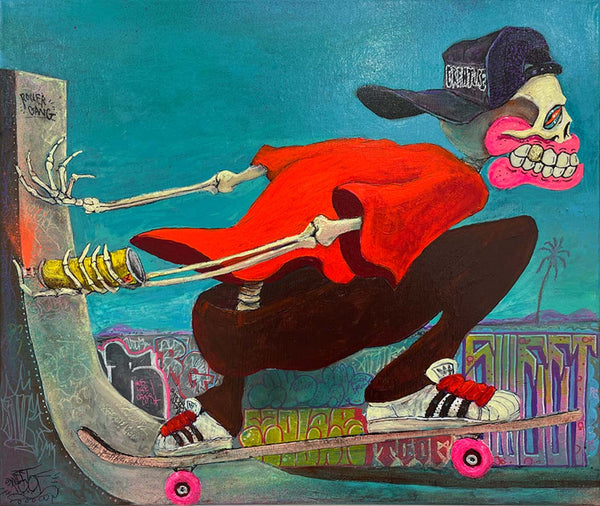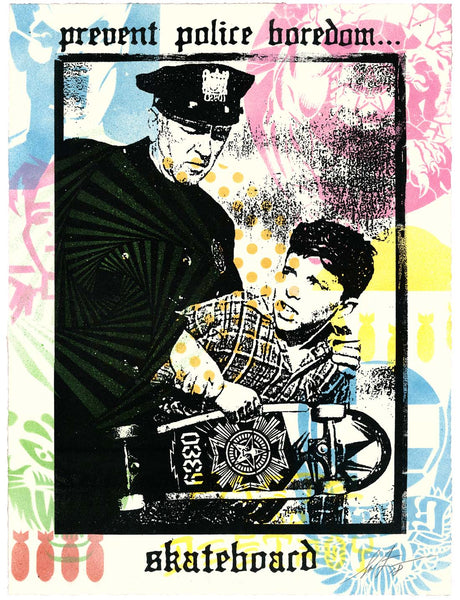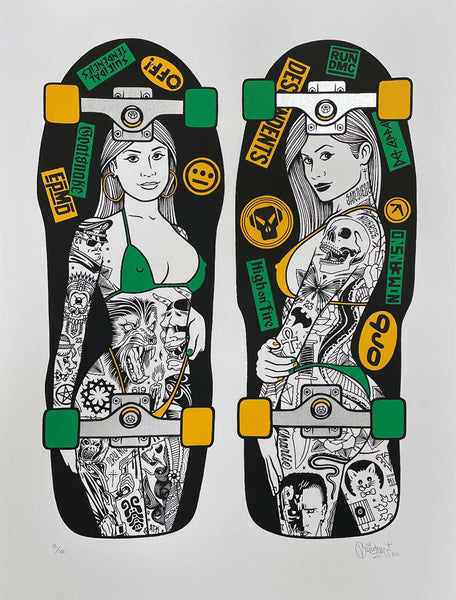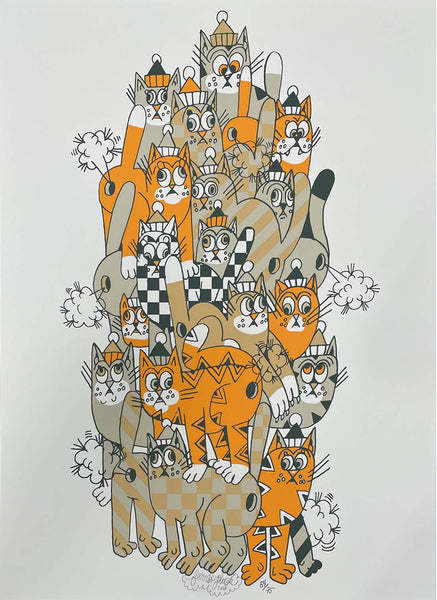I ONLY HAVE TO LAND IT ONCE
Featuring: Alphonzo Rawls, Andrew Pommier, Baghead, Bigfoot, Ben Tour, Billy Kheel, Bud Snow, Darin Balaban, Dave Kinsey, Derek Keenan, El Pez, Emek, Ferris Plock, Funeral French, Hama Woods, Hillary Lauer, Hege Skundberg, Jack Graydon, Jim Houser, Kai & Sunny, Lindsey Kuhn, Luke Ramsey, Mark Foster, Martin Whatson, Max Kauffman, Mike Giant, Mike Graves, Porous Walker, Rene Gagnon, Ricky Watts, Sam Flores, Sergio Garcia, Shepard Fairey, Skewville, Sweet Toof, Tes One and more
Exhibit runs November 13th - December 11th 2021
Black Book Gallery is pleased to present I Only Have To Land It Once, a group exhibition featuring the work of more than 30 artists — including Alphonzo Rawls, Andrew Pommier, Baghead, Bigfoot, Ben Tour, Billy Kheel, Bud Snow, Darin Balaban, Dave Kinsey, Derek Keenan, El Pez, Emek, Ferris Plock, Funeral French, Hama Woods, Hillary Lauer, Hege Skundberg, Jack Graydon, Jim Houser, Kai & Sunny, Lindsey Kuhn, Luke Ramsey, Mark Foster, Martin Whatson, Max Kauffman, Mike Giant, Mike Graves, Porous Walker, Rene Gagnon, Ricky Watts, Sam Flores, Sergio Garcia, Shepard Fairey, Skewville, Sweet Toof, Tes One and more — all of whom have been directly influenced by skater culture.
The exhibition will open on Saturday, November 13th and runs until Saturday, December 11th.
Each of the artists presented has a personal relationship with the skateboarding community—its ethos, brands, movies, tricks, camaraderie, and the DIY spirit that permeates the subculture.
To encapsulate the significance of the skater movement, the gallery asked several of the exhibiting artists to describe the impact that skateboarding has had on their lives and on their artistic development. Their individual answers testify to the deep bond each artist has to the subculture, its rituals, and the symbolism that skateboarding manifests.
“Skateboarding and punk rock saved my life,” says Shepard Fairey, whose early work plastered the streets with Andre the Giant’s likeness, and has since become best known for iconic murals, prints and posters that convey messages of social justice.
“Growing up in conservative Charleston, South Carolina in the 1980’s, attending a private prep school, I was miserable, mean, desperate, and about to blow,” Shepard explains. “Then I discovered skateboarding and its partner in visceral rebellion punk rock. Skateboarding gave me a visceral physical outlet, but also liberated me mentally and helped me find my voice and confidence. Skateboarding and punk had a very democratic, unintimidating, visual language and opened my eyes to the Do-It-Yourself empowerment potential of art.”
Luke Ramsey agrees. “Skateboarding influenced my approach to art making rooted in DIY ethics,” he says. “Take it anywhere, make it be anything one wants it to be, inspired by others, too.” Based in Victoria, Canada, the artist and illustrator creates brightly-colored and uplifting graphic work that has been commissioned by The New York Times, Patagonia, and the Cartoon Network. His work has been acquired by The Government of Canada and The City of Seattle, among other prominent collections.
Rich Jacobs is an artist and zine-maker based in California with a cult following. He cites “positive energy” as central to his practice and works in a range of mediums, from street art and graffiti, to pen and ink drawings, unique fonts, paintings, and murals. “Growing up a skateboarder changes the way you look at the world as a whole,” he explains. “I think mostly I think differently about flow, rhythm , music, sound and visuals. It is part of you for your whole life. Same with Art. They go together. It’s self expression. Looking at things deeper and more closely. Always being aware.”
Jack Graydon is a Portland-based artist and muralist whose work has graced the halfpipe bowl at the Vans US Open tournament. “I am constantly exploring and spot hunting for places to skate and paint,” he says. “They fill a similar space in my head and the journeys I make while skating influence my work.” Working primarily with spray paint to create his character-based compositions, the artist lists Mark Gonzales, Todd Francis, and Barry Mcgee as major artistic influences.
Rene Gagnon’s love of skating began as an affinity for BMX and graffiti. “In the very early 80's most of us east coast kids were heavy into BMX racing and freestyle,” he explains. “Then in '83 and '84 we were exposed to graffiti art with the movies 'Wild Style' and 'Beat Street'. Every kid that had a rebellious nature and also enjoyed creating art became a graffiti artist. At this exact moment in time another magical occurrence took place. We were exposed to the 'Bones Brigade' films. After that most of us ditched the BMX and got heavily into skateboarding. The skateboard became our sole mode of transportation for the long nights of marking our surroundings with our graffiti. So for me, graffiti and skateboarding are synonymous, and I continue to enjoy both activities to this day.” Rene’s work is best described as “post-graffiti urban expressionism” for his use of layered references ranging from drawings by Picasso to Hollywood celebrities and other pop culture motifs.
Similarly, Billy Kheel was also originally a BMX rider, but has since been introduced to skater culture by a surprising source — his daughter. His textile work featured in the exhibition is an homage to her and other female skaters. "I grew up in a small town in Massachusetts where freestyle BMX bikes were more popular than skateboarding,” he recalls. “It wasn’t until I got older and had a daughter who introduced me to female skateboarding pioneers Cindy Whitehead and Judi Oyama that I really began to appreciate the skill and diversity of skateboarding. I made these two mounted tapestries in honor of my daughter and these skateboarding legends."
Billy describes his work as “soft sculptures.” In addition to customized clothing, he creates wall hangings, installations and portraits that he composes using felt and thread. By employing historical fabric techniques to both commemorate and critique sports and pop culture, his work explores the boundary between art and craft, as well as the impact of shifting gender roles in contemporary culture.
Ricky Watts and Ben Tour both found early inspiration in the deck art they observed at local skate shops. “Skateboarding was more a means of transportation growing up,” says Ricky. “I never mastered many tricks but it got me from point A to point B nicely and was a catalyst to early art-making adventures. Looking back, I think I skated mainly for the excuse to hang out at the local skate shop and geek out on all the board graphics hanging on the wall.” Today, Ricky is known for his abstract compositions that combine organic shapes and undulating, psychedelic patterns with cascading color gradients. He was a 2021 artist in residence at Google and his work has been commissioned by major automotive, fashion and tech brands.
Ben remembers his introduction to the sport similarly. “Before I attempted to ride a skateboard I painted on discarded boards I’d found,” he says. “I’ve always been inspired by skateboarding and the risks involved with learning and achieving. I’ve applied that into my life and art-making — the best breakthroughs with painting happen when taking chances and experimenting.”
As a tribute to the skating community and its lasting impact on visual culture, I Only Have To Land It Once celebrates youthful rebellion while acknowledging how this uniquely American pastime has contributed to contemporary art and society at large.
The artists featured come from different backgrounds and work in varying mediums, but they all share the courage instilled by skating and the DIY ethics of the skater community — to embrace individuality and creativity, to determine one’s own path in life, and to always get back on the board.

